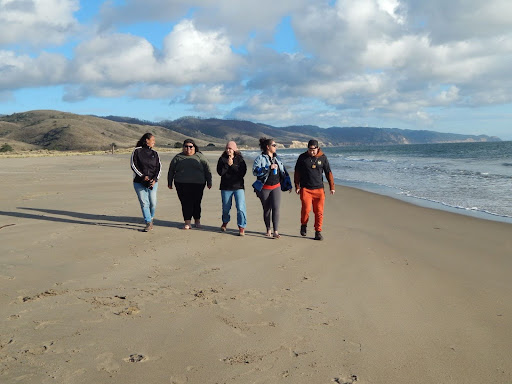Overview
Original Patriots: Cultural Revitalization & Healing Trauma in Native California (Part 3 of 3)

Author: Trelasa Baratta (Pomo, Primary author) & Taylor Pennewell (Maidu, Editor/Co-author) - Redbud Resource Group
Lesson partner: Rebecca Lowry and Maggie Peters, Humboldt County Office of Education
Grades: 9-12
Suggested Amount of Time: 75 minutes (1-2 class sessions)
Curriculum Themes
- Cultural Strengths
- Relationship to Place
Learning Goals
Students will evaluate the role of cultural revitalization efforts—such as Land Back, cultural burning, and food sovereignty—in addressing trauma, restoring Indigenous sovereignty, and fostering community resilience
Students will explain how cultural revitalization efforts, such as Land Back and environmental stewardship, help Native communities heal from intergenerational trauma and reclaim their identities.
Lesson Overview
This lesson examines how cultural revitalization serves as a tool for healing intergenerational trauma and reclaiming identity in Native California. Through exploring key concepts like cultural revitalization, Land Back, and environmental stewardship, students analyze real-world examples of resilience and cultural resurgence led by Indigenous communities. Activities include group discussions, the Land Back Spider Graph analysis, and a Webquest featuring case studies of Native leaders. The lesson emphasizes the importance of connecting cultural practices with wellness, combating stereotypes, and fostering a deeper understanding of Indigenous persistence and sovereignty.
The teacher must understand that despite our tragic history, Native communities continue to find hope, look to the future, and lead the way in repairing our relationships to local ecosystems. The teacher must be prepared to actively engage in conversations about resistance and resilience throughout this lesson.
Essential Questions:
How does cultural revitalization help Native communities heal from intergenerational trauma and reclaim their identities?
What role do the Land Back movement and environmental stewardship play in restoring Indigenous sovereignty and fostering resilience?
Students will engage with:
One Turn and Talk discussion.
Small group and class discussions.
A spider graph to analyze a Land Back Case Study.
Writing thoughtful responses to the Webquest guiding questions.
Teacher Background
Native communities in California have faced some of the most devastating impacts of colonization, genocide, and systemic oppression in U.S. history. From the mid-19th century through the California Gold Rush, state-sanctioned violence against Native peoples included forced removal, massacres, sexual violence, and ecocide. These events, now recognized as the California Indian Genocide, one of the most brutal periods in U.S. history, were deliberately funded and carried out to dispossess Indigenous peoples of their lands and resources. Many survivors of this genocide were coerced into adopting elements of settler culture to ensure their families' survival, resulting in incomplete but enduring cultural knowledge. However, Native communities have continuously resisted this violence through acts of resilience and survivance.
Despite the systematic attempts at erasure, Native communities in California remain vibrant and active today. Every California Native person alive today is a descendant of survivors who resisted and adapted to genocide. Their very existence is a testament to resilience and survivance—a concept that goes beyond survival to emphasize the active presence and thriving of Indigenous cultures.
Coined by Native scholar Gerald Vizenor, survivance describes the active resistance and continuation of Indigenous traditions, identities, and relationships to the land despite systemic violence. Survivance rejects narratives that portray Native peoples as relics of the past or victims frozen in history. Instead, it highlights their ongoing creativity, adaptability, and contributions to society. Survivance is particularly evident in contemporary movements to reclaim and revitalize culture, such as:
Cultural Revitalization: Programs focused on restoring traditional practices like cultural burning, language preservation, and ceremonies.
Land Back and Rematriation: Efforts to return lands to Indigenous stewardship as acts of healing for both the people and the environment.
Food Sovereignty: Projects that revive traditional diets and promote community health through sustainable practices. These acts demonstrate that while cultural knowledge may have been fractured, the fragments inherited from ancestors serve as powerful tools for revitalization.
Framing the Narrative for Students:
When teaching this history, it’s essential to communicate that the California Indian Genocide, though devastating, did not succeed in eradicating Native communities. Resilience and resistance ensured the preservation of traditions, languages, and identities. This reframing challenges harmful stereotypes, such as the idea that Native people no longer exist or that they are only victims of history.
It is equally important to show how these historical injustices connect to the disparities Native communities face today—such as higher rates of poverty, health issues, and underrepresentation. Yet, these disparities do not define Native communities. Instead, the focus should remain on their ongoing contributions to cultural and ecological resilience.
By understanding cultural revitalization, students can celebrate the strength of Indigenous peoples and learn how contemporary cultural revitalization connects to broader efforts for justice and healing. This perspective equips students with tools to reflect on their own roles in fostering respect, equity, and collaboration.

